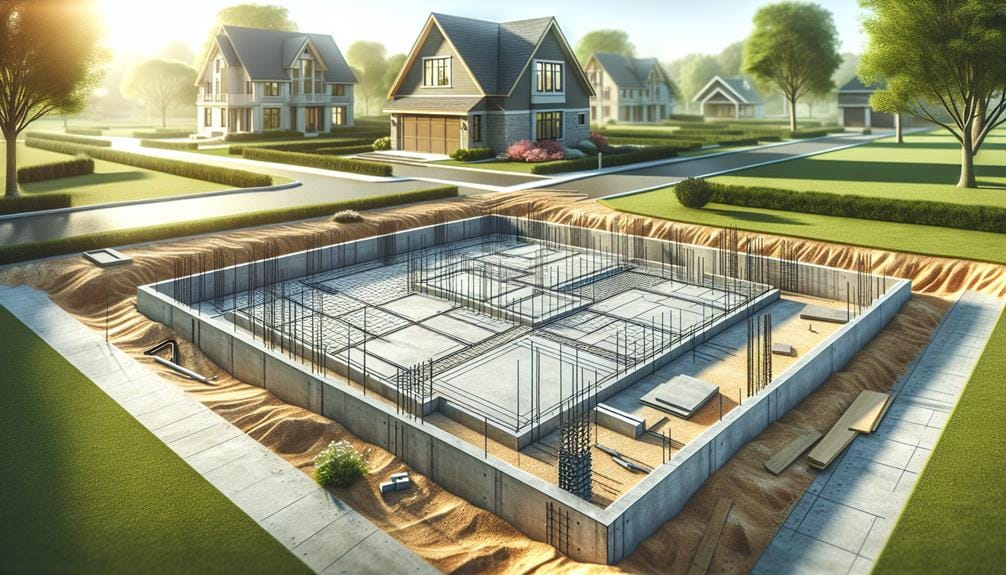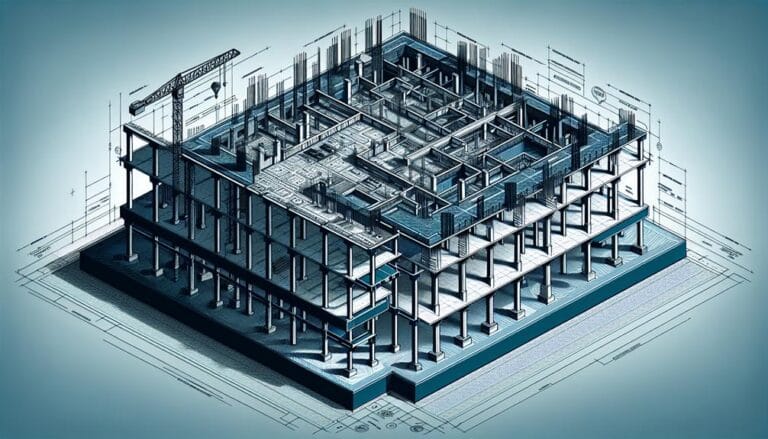What Are Slab-On-Grade Foundations?
Slab-on-grade foundations are concrete slabs poured directly onto the ground, providing a stable base for our structures. We build these foundations in a single layer, often with additional footings under load-bearing walls or at the edges. With both cost and energy efficiency in mind, we avoid crawlspaces and basements, which also helps with termite resistance. Suitable for warmer climates and regions with no need for deep foundation support, slab-on-grade foundations have gained popularity in residential construction. Knowing these basics will give us a solid footing; now, let's uncover even more about this common foundation choice.
Key Takeaways
- A slab-on-grade foundation is a cost-effective and structurally strong concrete slab poured directly onto the ground without a basement or crawlspace.
- This type of foundation efficiently supports walls and load-bearing requirements, reducing environmental impact through reduced resource use and lower long-term maintenance costs.
- Slab-on-grade foundations are well-suited for warmer climates with low frost lines, making them a popular choice for residential and commercial construction projects.
- Effective preparation and proper insulation measures, such as vapor barriers and rigid insulation, enhance the thermal energy efficiency and prevent water damage.
Advantages of Slab on Grade
Slab-on-grade foundations offer several key advantages that make them a popular choice for many construction projects. One major benefit is that they are cost-effective. Slab-on-grade foundations require less material and labor compared to other types, making them a budget-friendly option. In addition, they can help reduce environmental impact by reducing the use of resources for excavation and material transportation.
Another significant advantage is that slab-on-grade foundations provide effective structural integrity. They can support walls, upper floor constructions, and load-bearing requirements efficiently, making them suitable for both residential and commercial projects. Moreover, slab-on-grade foundations are less vulnerable to termite infestations, which can save homeowners and builders significant costs in the long run.
When designing with slab-on-grade foundations, we consider factors like soil requirements and the design specifications of the project. This guarantees that the foundation can support the structure without compromising its stability. Overall, the low upfront costs, long-term durability, and reduced environmental impact make slab-on-grade foundations an attractive choice for building professionals and homeowners alike.
Common Applications and Needs
When building in warmer climates or on projects that do not require basements, we often turn to slab-on-grade foundations. This type of foundation excels in environments with low frost lines, where the ground doesn't freeze and thaw considerably. Additionally, slab-on-grade foundations are well-suited for projects that do not need heat ducting under the floor.
In residential construction, slab-on-grade foundations are popular due to their cost-effectiveness and ease of building. They work well in regions with clay soil, where traditional deep foundation options might not be necessary. This makes them a great choice for projects where the living space above is relatively light and easily supported by a floating slab.
For commercial applications, slab-on-grade foundations offer a range of advantages. They are more cost-effective due to simpler labor requirements and fewer materials needed compared to other types of foundations. This simplicity also translates to better insulation and reduced heating costs. Overall, slab-on-grade foundations provide an effective, economical solution for both residential and commercial projects in the right environments.
Material Uses and Benefits
We start constructing slab-on-grade foundations by initially preparing the ground. This involves laying down a layer of vapor barrier to prevent moisture infiltration and optimizing drainage. We then pour a concrete slab over this prepared surface. For enhanced strength and integrity, we incorporate reinforcing materials like wire mesh and rebar.
The foundation design dictates the use of specialized materials to meet specific requirements. For instance, in areas with extreme weather conditions, thickenings in the slab provide added support. Our focus on proper building codes and regulations guarantees that the slab meets the necessary load-bearing capacities. Additionally, we adapt the construction materials and techniques to accommodate varying soil conditions, securing a solid foundation.
The use of this technique provides several benefits. Not only is it cost-effective, but it also reduces the carbon footprint by minimizing the use of materials. This approach also provides a highly insulated wall assembly, tending to energy efficiency and maintaining a comfortable indoor environment. By considering local climate and environmental factors in our design, we craft foundations that stand the test of time and for every dollar spent.
Thermal Energy Efficiency
In our slab-on-grade foundation design, energy efficiency is critical; tiny details like guaranteeing a quality vapor barrier, insulation under the slab, and using high-performance materials can make a significant difference in reducing heat loss and maintaining a comfortable indoor environment.
To optimize energy efficiency, we implement several insulation techniques, including:
- Installing rigid insulation along the perimeter of the slab to minimize heat loss.
- Using a capillary break and moisture barrier to prevent water wicking and guarantee a dry and well-drained environment.
- Incorporating a vapor diffusion retarder to further reduce moisture infiltration.
- Guaranteeing proper grading and drainage to prevent water accumulation near the foundation.
These measures collectively contribute to significant energy conservation, resulting in a more comfortable and economical living space. By focusing on these often-overlooked details, we can create buildings that not only reduce their environmental footprint but also provide a better experience for the people who use them.
Durability and Long-Term Value
When it comes to the durability and long-term value of slab-on-grade foundations, proper planning and execution are essential. Properly installed vapor barriers and high-quality under-slab insulation can greatly extend the lifespan of our buildings by preventing moisture infiltration and reducing the risk of structural damage. This protection not only saves us from costly repairs but also guarantees the foundational integrity of our homes.
Here is a summary of the key factors that enhance foundation longevity and structural integrity:
| Parameter | Impact | Consequences |
|---|---|---|
| Moisture Protection | Prevents Water Damage | Reduces Cracking, Rot, and Frost Heave |
| Compressive Strength | Supports Heavy Loads | Prevents Slab Deformation and Failure |
| Structural Design | Manages Soil Settlement | Minimizes Foundation Cracking and Structural Issues |
Resistance to Natural Disasters
Slab-on-grade foundations demonstrate varying degrees of resistance to natural disasters, especially earthquakes and floods. As homeowners, we need to evaluate the potential risks associated with these types of foundations when building in areas prone to such disasters.
Earthquakes can be particularly damaging to slab-on-grade foundations, as the lateral loads generated by seismic activity can cause the foundation to crack or fail. To mitigate this risk, it is vital to incorporate earthquake-resistant features during construction, such as:
- Anchoring the foundation: Connecting the house walls to the foundation using anchor bolts or approved connectors to guarantee a strong connection.
- Building bracing: Instilling continuous structural wood sheathing to provide additional support.
- Control layers: Implementing layers for air, vapor, thermal, rainwater, and groundwater control to make sure the foundation remains stable.
- Thermal insulation: Insulating the foundation thermally to maintain its integrity.
These measures can greatly enhance the earthquake resilience of slab-on-grade foundations. Additionally, provisions for flood protection, such as elevating the foundation or using water-resistant materials, are essential for homes built in flood-prone areas. By incorporating these design elements, we can help guarantee our homes remain secure and safe in the face of natural disasters.
Initial Cost and Maintenance
We should evaluate the potential financial burdens associated with the construction and upkeep of slab-on-grade foundations, as they can impact our decision-making process. While slab-on-grade foundations are generally known for being cost-effective, there are other important budget factors we should keep in mind. After initial installation, maintenance is essential for ensuring the foundation remains structurally sound. Here are some key points to evaluate:
| Feature | Cost Impact |
|---|---|
| Initial Construction | Lower initial cost due to no basement or crawlspace |
| Maintenance | Regular inspections and repairs can be less costly long-term |
| Reinforcement | Rebar or cable reinforcement necessary for structural integrity |
| Climate Factors | Warmer climates can mean lower utility bills |
| Long-term Durability | Lower maintenance needs can save on repair costs |
Installation Process and Time
In an article titled 'Slab-On-Grade Foundations,' we are now discussing the installation process and time.
Constructing slab-on-grade foundations typically involves less construction time, as it eliminates the need to excavate a basement or crawlspace. This simplified process makes them faster to install, which translates to cost savings for homeowners. The basic steps involve preparing the site, placing form boards to frame the slab edges, digging a grid of trenches for footings and interior beams, and pouring the concrete.
Key Steps in the Installation Process:
- Preparation: Fill, slope, and level the ground as needed.
- Forming: Place wooden boards to frame the slab edges.
- Footings: Dig trenches for footings and interior beams.
- Pouring: Insert rebar reinforcements, line the trenches with a moisture barrier, and pour the concrete.
Throughout the process, it is essential to guarantee proper curing methods to achieve ideal strength. The reduced construction time, along with simpler installation techniques, contributes to the cost-effectiveness of slab-on-grade foundations.
Termite Resistance and Pests
Diving into the domain of slab-on-grade foundations, we now explore the vital aspect of termite resistance and pest control.
One of the benefits of slab-on-grade foundations lies in their termite resistance since there is no hollow space between the ground and the structure. Termites can cause significant damage to homes, so it is important to utilize techniques that minimize the likelihood of infestations. Buildings constructed using slab-on-grade methods are inherently more resistant to termite attacks because there is no void for the pests to inhabit. This means that termite prevention methods are less necessary, saving homeowners time and resources in the long run.
How do slab-on-grade foundations compare to others regarding termite resistance?
````
| Foundation Type | Termite Resistance | Advantages |
|---|---|---|
| Slab-on-Grade | High | No space for termites, reduced pest control needs |
| Basement | Low | Hollow space under the floor for termites, more control measures |
| Crawlspace | Medium | High potential for termites due to dark, damp conditions |
```
As we examine the advantages and limitations of each foundation type, it becomes clear that slab-on-grade structures are designed to inherently reduce the likelihood of termite infestations. By removing the habitat for these pests, homeowners can focus on other aspects of maintaining their homes.
Frequently Asked Questions
Can Slab-On-Grade Foundations Be Extended or Remodeled?
"We often find that slab-on-grade foundations are challenging to extend or remodel due to their thin profile and lack of supporting structures. This makes it difficult to add new components without significant reconstruction or alteration."
How Can Soil Settlement in Slab-On-Grade Foundations Be Repaired?
"We use various foundation repair methods when addressing soil settlement in slab-on-grade foundations. Options include soil stabilization techniques like piers and slurry injection to lift and stabilize the slab, often requiring extensive underside work."
What Is the Thickness of a Standard Slab-On-Grade Foundation?
It is understood that a standard slab-on-grade foundation is about 4 to 6 inches thick. Plus, we can add insulation to prevent moisture and heat loss if we guarantee this appropriate standard thickness during construction.
Are Slab-On-Grade Foundations Prone to Damage From Earthquakes?
It is understood that our slab-on-grade foundations are relatively sturdy, but what about earthquake resilience? They can handle minor tremors fine, but severe earthquakes can cause foundation stability issues due to the concrete's rigidity.
Can Slab-On-Grade Foundations Be Used in Areas With High Water Tables?
It is understood that water tables can be unpredictable, so we suggest using water drainage systems and moisture barriers under the slab to prevent damage from water and moisture.







